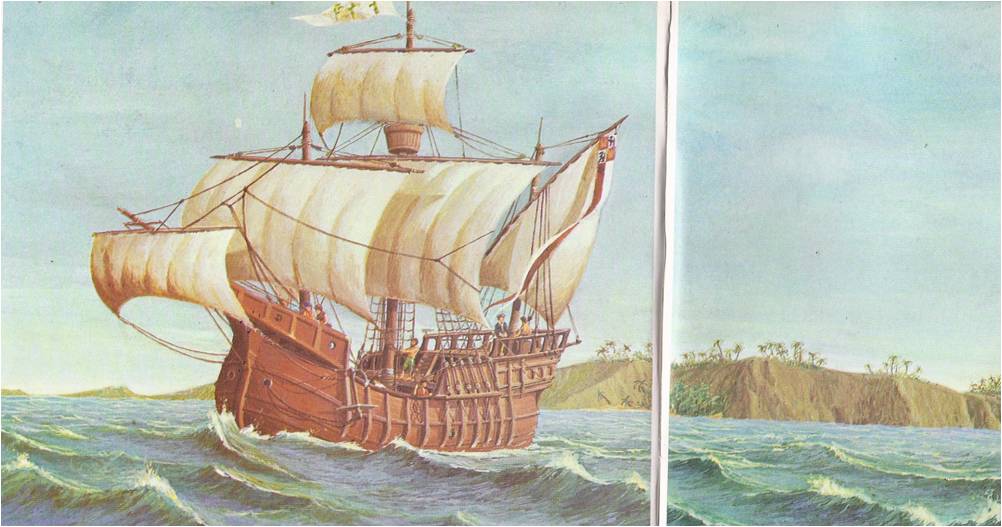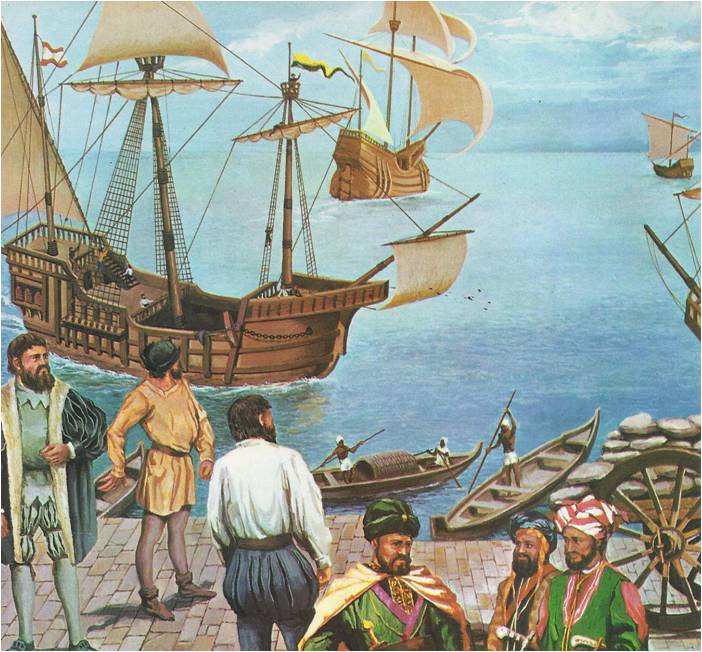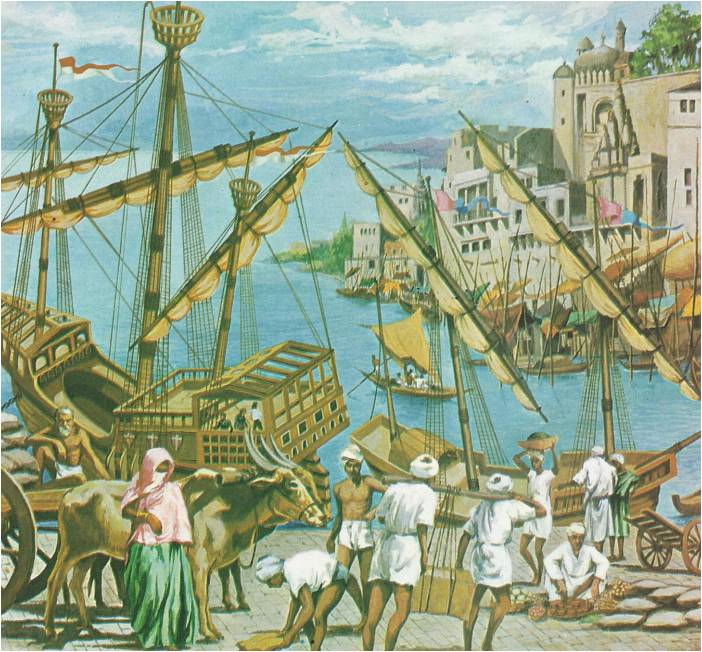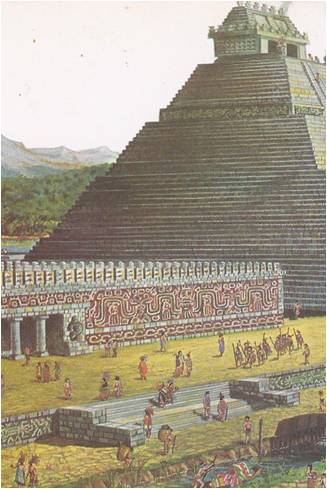IN 1415, WHEN ALL OF CHRISTENDOM belonged to one church and Christians battled pagan Turks instead of one another, a force of Portuguese marines set sail for the coast of Africa. They planned to attack a town called Ceuta. A stronghold that guarded the narrow passage connecting the Mediterranean Sea with the Atlantic, Ceuta was the end link in the chain of fortresses and well-armed ports that the Turks had tightened around the southern and eastern boundaries of Europe. Held in by this chain, European merchants could not trade in the luxury-filled markets of the east, pilgrims could not journey to Jerusalem and missionaries could not carry the word of God to the countless “lost souls” of Africa and the Indies. While the Turks held Ceuta, it was dangerous for the merchants of northern and southern Europe merely to trade with one another. So the king of Portugal sent out an expedition of his toughest marines. At their head he placed his own son, Prince Henry, who was young but skilled in the tactics of war. With a favourable wind driving his ships at top speed, Prince Henry caught the Turks by surprise. He sank their fleet, destroyed their docks‚ burned their town and triumphantly sailed home to announce that the sea routes were free once more.
The king rewarded his son by naming him master of the Naval Arsenal at Sagres, the port of Lagos and all of the Cape of St. Vincent, the rocky headland that jutted like a pointing finger from southern Portugal into the Atlantic. Prince Henry was delighted. Ships and the sea were his love and his life and he had many ideas for the fleet that now was his to command. These ideas were the beginning of a great age of exploration. They would change the shape and size of the world that Europeans knew, just as Luther’s ideas had changed their religion.
THE ROUTE TO THE INDIES
Prince Henry was a dreamer. When he sat in his study, gazing past the boatyards and harbour to the sea beyond, he saw in his mind a fleet of tall, broad ships riding the open ocean. He saw these ships set forth with settlers and priests, Bibles and church bells, to sail far down the coast of Africa, past the territory of the Turks. He saw them sail on to the tip of Africa, then east to India, the Islands of Spice and the land of Prester John. Prester John was a fabled Christian monarch whose kingdom had never been seen by any man from Europe, but was said to be vast and rich beyond belief. Once it was found, the Christians of Europe would join forces with Prester John. The Turks would be surrounded, then conquered and converted.
Alone in his study, staring at the sea, Prince Henry let his mind race on. He saw his ships return to Lagos laden with rich cargo, with silk and jade, pearls and indigo dye. From the holds came the savoury odors of ginger and cinnamon, camphor and frankincense, pepper, nutmeg and clove — all the rare, expensive herbs and spices that Indians grew and Europeans longed for.
Prince Henry was indeed a dreamer and many experienced mariners said he was a fool. “Shiploads of spices direct from the East?” they said. “Impossible.” The route to the Indies was over land as well as sea and so it had been for nearly 3,000 years. The spices that reached India from the Islands of Spice had to be carried by caravans across the width of India to ports on the Indian Ocean. There they could be loaded into ships and sent to Arabia or Persia. After that came a second journey by caravan the long, dangerous journey through the wastelands of Arabian desert to Constantinople and Alexandria and the other eastern Mediterranean ports. Only then could the precious cargo be carried to the coasts of Europe by ship.
Anything that traveled so far had to be expensive, for each ship captain, each caravan leader, had to be paid. Goods that sold for next to nothing in the markets of Calicut in India were luxuries in Europe. Now things were worse than ever. Turkish warriors had swept across Arabia and the north of Africa. They had taken charge of the caravan trails and occupied Constantinople and Alexandria. Many Turks, loyal to their Moslem religion, refused to trade at all with “infidel dogs,” as they called Christians. Turks still willing to do business charged fantastically high tolls to let goods pass through the ports and roads they controlled. The result was that trade with the East had all but stopped.
Europeans missed the pearls, the silks and the jade, but most of all they missed spices. There had never been much variety in food in Europe — few vegetables or fruits, no coffee, tea, or chocolate, no tomatoes or potatoes. In winter there was little more than lumpy bread, scorched cakes (unsweetened, for sugar was only for kings) and a main course of meat that had been pickled during the summer. Since the days of the Crusaders, there had been spices to make food more tasteful. Now spices were disappearing from the shops. The merchants sighed and wished that they could believe in Prince Henry’s dream — but of course it was impossible.
SCHOOL FOR MARINERS
Old seamen and men who had studied the best books of geography also shook their heads when they heard of Henry’s scheme to sail to India. “Around the tip of Africa?” they asked. “How does his highness know that there is a tip of Africa? Perhaps the land goes on and on to the Pole. No one has gone to see and no one will, for beyond the great bulge in the African coast, the Cape of Bojador, there is water that foams and eddies like a whirlpool — the Boiling Sea. Everything gets hotter as a ship heads south and if a ship sails too far in that direction it will come to a place where the sunlight turns into flames and the ocean seethes like a soupkettle. That’s a place fit only for devils and only devils live there – sea monsters, water dragons, mermaids with hair of fire and huge snakes that can wrap themselves around a ship and crush it like an egg.
These were wild tales but most sailors and many learned men believed them. Maps drawn by famous geographers even showed the places where the monsters would be found.
Prince Henry called the stories nonsense. He was more than a dreamer; he was a scientist who looked for practical explanations of the things that puzzled or frightened men. He said that sailors had good reason to fear voyages far into strange waters. After all, their mars were poorly drawn and full of errors and their captains had no instruments to help them chart a course. It war these things, not monsters that kept sailors close to well-known coasts, where familiar landmarks could serve as guides. Henry insisted that ways could be found to overcome the real danger of the open sea — and then sailors would discover the route to the Indies.
Henry never went to sea himself but he set up a school to train his mariners. To his court at Sagres he summoned mapmakers, scholars, navigators, scientists and mathematicians from Europe and the East. Some he set to pouring over old books, seeking out the forgotten discoveries of ancient scientists and explorers. Some he persuaded to reveal the hard-won secrets of lifetimes spent at sea — the locations of reefs and shoals‚ the ways the currents flowed, the patterns of the winds. The scientists designed new instruments. They also taught Henry’s mariners the principles and uses of the compass and the astrolabe, a device for measuring longitude and latitude. Both instruments had long been known but rarely used at sea.
While the mariners went to school, Henry encouraged shipbuilders to experiment with new designs. The old vessels, built to hug the coast, were not sturdy enough to battle the waves on the open seas. After a time, plans for a new kind of ship were given to the shipwrights in his Naval Arsenal. As Henry waited impatiently, they turned out the first fleet of the ships called caravels.
The caravels were small and wide. Built up from their decks, fore and aft, were high structures called castles. Old sailors said the new vessels looked strange, but Henry was certain that they were ships that could conquer the open seas. To test them and his newly trained mariners, be sent an expedition westward, on the Ocean Sea, the vast Stretch of water that one day would be called the Atlantic. No one had ventured far in that direction for four hundred years, since the voyages of the last of the Norse adventurers. Now, in 1432, the most daring of Henry’s crews sailed nearly eight hundred miles away from the shore of Portugal. They might have gone further still, but they sighted a sprinkling of islands — the Azores — and hurried home with news of their discovery. New expeditions carried settlers to the islands. Traders followed and hard-headed merchants no longer sneered at Henry’s fantastic dreams.
For Henry, this was just a beginning. Now that his ships and men had proved themselves‚ he ordered them to sail southward, to the tip of Africa. Year after year, the caravels set out, sailed a thousand miles or so down the African coast and stopped at the Cape called Bojador. The water at the cape was foam-white — boiling, just as the old stories said.
IVORY, TIMBER AND SLAVES
In 1433, Gil Eannes, Henry’s bravest captain, returned from Bojador. His sailors had refused to go on. Henry tried to be patient. He reminded Eannes that there was a spot along the familiar Portuguese coast where the water hissed and boiled. That was caused by shoals — shallow water above sand bars or rocks. Sailors simply sailed around it. Couldn’t the “boiling water” at Bojador also be the result of shoals?
“If there were any truth in these sailors’ tales,” Henry added more sternly, “I would not blame you, but you come to me with the stories of seamen who may know the voyage to the Lowlands or some other route along the coast, but, except for that, don’t know how to use compass or sailing chart. Go out again and pay no heed to these tales, for with God’s help, fame and profit must come from your voyage, if you will only persevere.”
In 1434, Gil Eannes and his men set sail again. Henry ordered them not to return without a good report of the Cape and the ocean beyond. When the ship neared Bojador, Gil Eannes steered far out on the open sea, passed the cape, then turned again toward shore. There he found water “as easy to sail in as seas at home” and land “very rich and pleasant.” No sea monster rose from the depths to attack the ship. When the crew went ashore, they found trees and vines and flowering plants “such as were called in Portugal St. Mary’s roses.” The sailors collected some of the plants and presented them to Prince Henry when they reached home.
Thus Bojador was conquered and a part of Henry’s dream had come true. For the first time, Christian men had touched land beyond the territory controlled by the Moslem Turks. Henry sent out ships that went still farther down the coast of Africa. Trading posts were set up. Ivory, lumber and other African goods were carried back to Portugal and sold for good prices in European markets. The captains of the caravels soon discovered another, uglier trade, one from which the Arabs had long profited: the seizing and selling of Africans as slaves.
Portugal, once a poor little country dependent on her fishermen, profited from trading in ivory, timber, and slaves. She became a power on the seas, the owner of line fleets of armed merchant vessels and a string of ports along the coast of Africa, Of course trading slowed exploration. When Prince Henry died, in 1460, his dream of a sea route to the Indies had not yet come true, but now many men who followed the sea shared his dream. Pushing ever farther south, they used the instruments developed in his navigators’ school, plotted their courses on the accurate charts his map makers had drawn and calmed the fears of their crews by reminding them of the common sense of Prince Henry, whom they called Henry the Navigator.
THE OTHER SIDE OF AFRICA
In 1482, Captain Cam of Portugal sailed far south to the mouth of the River Congo and five hundred miles beyond. To mark his progress‚ he set up new tall pillars at each place he landed. Five years later, Bartholomew Diaz, another Portuguese, sailed past the last of Cam’s pillars and into a Stretch of ocean where nothing seemed to be as it should be. First the winds and then the currents, shifted; they ran in the opposite direction to the winds and currents that Europeans knew. The sailors called it devils’ work and cried in panic to turn back. Captain Diaz insisted that there must be an answer in nature to such strange happenings. Perhaps, he suggested, the ship had come to the southern part of the world, where the flow of winds and water might well turn in opposite directions to those of the north. Setting a course away from land, he followed the strange currents and breezes until his ship was carried toward the east and north. When he sighted land again, it was to the north — a coastline, gradually curving eastward that could only be the other side of Africa. Then Diaz knew that Prince Henry had been right. There was a tip of Africa and now a ship had sailed around it.

VASCO DA GAMA
When Diaz returned to Portugal, his report to King John II set off an uproar of excitement in the court. The king’s ministers rushed to organize new expeditions, longer voyages that would lead to India or China. Shipwrights were commanded to build new ships‚ while merchants clamoured to share in the eastern trade. No one had time to talk to a captain from Genoa, an adventurer called Christopher Columbus, who was trying to raise money for an expedition that he said would reach the East by sailing west. Two or three royal advisers looked at Columbus’ charts, listened to his plan and promised to say a word to King John, but the king was busy with Captain Diaz. Columbus waited, grew discouraged and finally left for the court of Spain.
Meanwhile, despite the excitement, the great expedition around the tip of Africa was delayed for nearly ten years. The plan grew less ambitious. There were only four ships, manned by one hundred and eighty men, in the fleet that finally set out in 1497 under the command of Vasco Da Gama.
Bad luck seemed to dog the expedition. Beset by gales, Da Gama took three months to sail down the western coast of Africa. Then, for four days, he battled fierce winds that all but stopped him from rounding the tip at all. As he sailed up the eastward-leading coastline that Diaz had discovered, Da Gama’s storeship ran out of supplies. His men were hungry and many were sick — bleeding without reason, their bodies covered with sores. A number of them died. They were victims of scurvy, a sickness that would be the plague of seamen on long voyages. Not for years would it be discovered that scurvy was brought on by a diet lacking fruits or vegetables with vitamin C.
More of Da Gama’s sailors died, until his ships were dangerously undermanned. He could only order the empty supply ship burned, use her sailors to fill out the crews of the other three caravels and push on into regions where no European had sailed before.
THE VOYAGE TO CALICUT
Now his luck seemed to change. Along the coast he came upon one port after another, Moslem and Arab trading towns that did a brisk trade with India. The Easterners were astonished to see men from Europe sailing on a sea that they thought of as their own and some were far from pleased. There were plots to sink the ships or burn them and to massacre the crews, but Da Gama kept a strong guard posted whenever he put into port. He found merchants willing to sell him food and in the town called Zambesi, he came upon a friendly Arab navigator who agreed to pilot him across the Indian Ocean. The Arab set a course for Calicut and on a sunny morning Da Gama’s ships sailed into the harbour. They had made the voyage from Europe to India; Prince Henry’s most fantastic dream had come true.

Crowding on the decks, the Portuguese sailors stared in wonder and disbelief. Calicut was one of the five great harbours of the world, the booming centre of trade between Arabia and the Indies. Its docks were crowded with ships — little island-going boats with odd-shaped sails, ships of war, great ocean traders and the gilded yachts of Indian lords. Along the waterfront a babble of strange tongues rose from the busy throng. There were small dark men wrapped in folds of brilliant cloth, orientals in coats of heavy Silk and turbanned Arabs with black beards and faces toughened by the wind and sand of the desert. Beyond the ships and waterfront lay the markets of Calicut, with dazzling displays of silks and brocades, of pearls and precious gems, baskets heaped with cinnamon, ginger, pepper, cloves, nutmeg, the spices that in Europe were nearly as rare and costly as jewels.
To trade with the merchants dealing in such luxuries, Da Gama had brought three shiploads of tin-ware and cheap cloth. When he offered to exchange his cargo for spices, the Easterners simply laughed at him. Though he was bitterly disappointed, Da Gama put a smile on his face and invited the Indians to visit his Caravels — a friendly gesture, he said. Once the visitors were on board, he made them prisoners and held them until their friends had filled the holds of his ships with the spices he wanted. Then he sent the Indians ashore, hoisted sail and hurried away.

PORTUGUESE EMPIRE
The voyage home was long and hard. On the Indian Ocean, gales buffeted the ships, then the wind died down completely and they were becalmed. More sailors died as the caravels slowly made their way down one coast of Africa and up the other. Another ship was burned because there were too few crewmen left to man her. In September‚ 1499, Da Game finally docked his caravels at their home port in Portugal. His voyage had taken more than two years. He had sailed 24,000 miles and spent in all nearly a year on the open sea out of sight of land. Of 180 men who set out with him, only 50 returned. He had found a sea route to India. Now Portugal could reach the riches of India and the lands beyond — China, called Cathay; Cipangu, or Japan; Ceylon and Malabar; Borneo and Amboyna; and the real Islands of Spice, Tidor and Ternate, the only places in the world where clove trees grew.
The king rewarded Da Gama by naming him a count (a clove was a part of his new coat of arms) and quickly sent expeditions to claim and hold the new sea route for Portugal. Warships were dispatched to deal with the hostile Arabs along the eastern coast of Africa. Soldiers were shipped abroad to seize ports in Africa and along the shores of the Indian Ocean. After the soldiers, came merchants and settlers, who built fortified trading posts, called factories, on the Indian seacoast. For each post and port, the king appointed a governor, or viceroy. The governor’s duty was to hold the land around his settlement, to win the friendship of the natives or beat them into obedience.
No longer did the Portuguese offer tin and poor cloth to the merchants of the Indies. They paid with silver and gold and gladly, for spices were cheap in the Eastern markets and worth a fortune in Europe. Each year about twenty merchant ships set sail from India to Portugal. The cost of the voyage, including ship and cargo, was nearly $20,000; the value of the cargo at the end of the voyage could amount to as much as $750,000. Few ships were lost — two or three a year — for there were fifty-two Portuguese ports to provide safety and supplies and fleets of Portuguese warships guarded the stretches between the ports.
Prince Henry’s dream, come true, made Portugal rich. Of course, no one ever found the kingdom of Prester John; it was only a legend, after all. The sea route to the Indies was real and for nearly a century it belonged only to Portugal. Then other, larger nations began to demand a share of the trade and the profits. They enforced their claims with warships and little Portugal could not supply enough ships or men to guard her wide spread empires. Her power faded, new merchantmen sailed the Indian sea route and new adventurers, remembering Prince Henry the Navigator, explored the unknown oceans.





